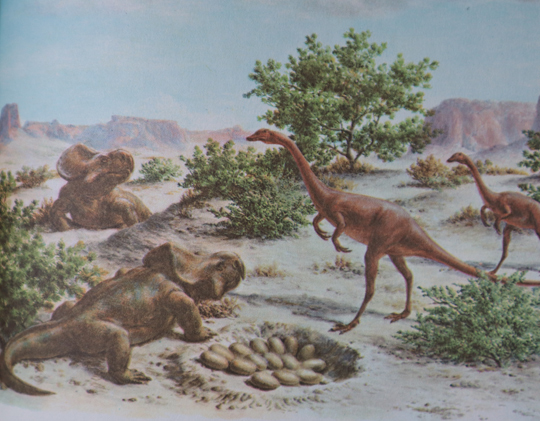A team of paleontologists from the United States, Canada and Argentina has analyzed the fossilized eggs of two different non-avian dinosaurs, Protoceratops and Mussaurus, and found that the eggs resembled those of turtles in their microstructure, composition, and mechanical properties. They’ve also found that hard-shelled eggs evolved at least three times independently in the dinosaur family tree.

The exceptionally preserved Protoceratops specimen includes six embryos that preserve nearly complete skeletons. Image credit: M. Ellison / American Museum of Natural History.
For many years there was scant fossil evidence of dinosaur eggs, and all known examples were characterized by thick, calcified shells — leading paleontologists to speculate that all dinosaur eggs were hard-shelled, like those of modern crocodiles and birds.
“The assumption has always been that the ancestral dinosaur egg was hard-shelled,” said study first author Dr. Mark Norell, chair and Macaulay Curator in the Division of Paleontology at the American Museum of Natural History.
“Over the last 20 years, we’ve found dinosaur eggs around the world. But for the most part, they only represent three groups: (i) theropod dinosaurs, which include modern birds; (ii) advanced hadrosaurs like the duck-bill dinosaurs; (iii) and advanced sauropods, the long-necked dinosaurs.”
Dr. Norell and colleagues studied embryo-containing fossil eggs belonging to two species of dinosaur:
(i) Protoceratops, a sheep-sized plant-eating dinosaur that lived in what is now Mongolia between about 75 and 71 million years ago;
(ii) Mussaurus, a long-necked, plant-eating dinosaur that grew to 6 m (20 feet) in length and lived between 227 and 208.5 million years ago in what is now Argentina.

The fossilized egg of Mussaurus. Image credit: Diego Pol.
The researchers focused on the mineral and chemical compositions of the fossils, including a dark-colored halo surrounding the fossilized embryos.
“We looked for any residue of a protein eggshell membrane,” said study co-author Jasmina Wiemann, a graduate student in the Department of Geology & Geophysics at Yale University.
“We essentially ‘fingerprinted’ a large number of modern and fossil samples to build a dataset of the overall molecular picture of the eggshell through time.”

The scientists found that the early dinosaur eggs had a chemical residue that was non-mineralized — meaning they were more like today’s leathery turtle eggs, protecting their embryos with a soft outer covering.
“These dinosaurs buried their eggs in clutches, like modern animals that lay soft eggs, such as many lizards, snakes, and turtles,” Wiemann said.
“This kept the eggs moist and protected. It works very well.”

The discovery also shows that the three main branches of dinosaurs — Ornithischia, Sauropodomorpha, and Theropoda — each started with soft eggshells.
Hard, calcified eggshells evolved independently for each branch.
“By taking a step back and looking at the molecular data, we found that in this case (their eggshells) early dinosaurs were more reptilian than bird-like in their reproductive behavior,” said Matteo Fabbri, a graduate student in the Department of Geology & Geophysics at Yale University.
Source: sci.news








